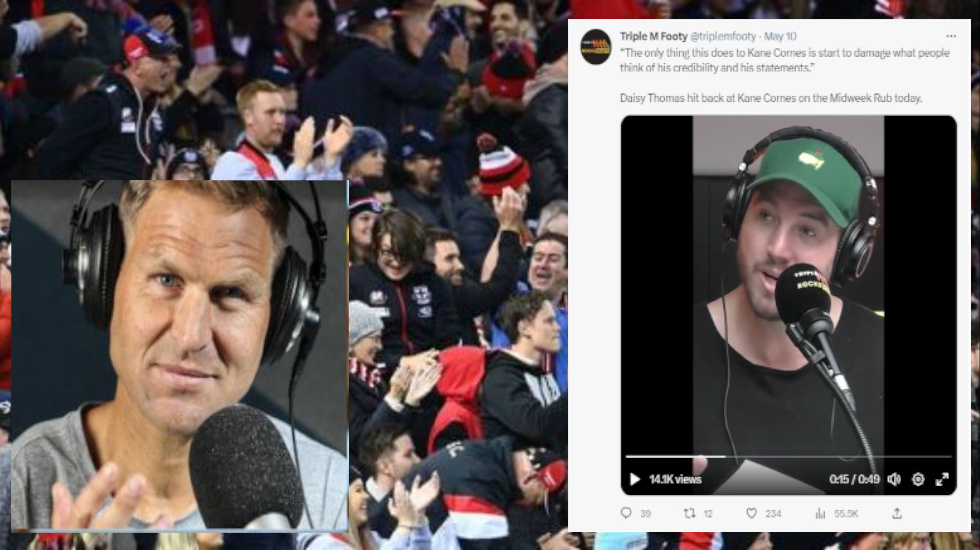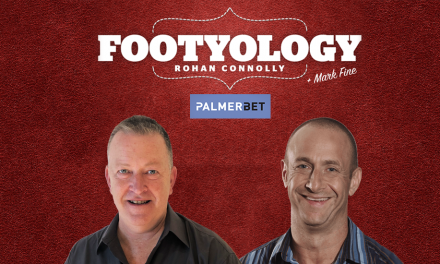Kane Cornes and Dale Thomas: It was hard to remember just who ended up hitting back at whom?
The chicken or the egg? I find myself asking that question a lot these days. Particularly when it comes to coverage of AFL football.
Did the football public indicate a desire for increasing amounts of clickbait which media outlets then catered to? Or did those outlets at first speculatively throw out some provocative piece of content which was lapped up?
More specifically, did former Magpie turned media man Dale “Daisy” Thomas or now-established media provocateur Kane Cornes fire first in their latest spat?
I actually seriously lost track as I read another breathless tweet from a media account detailing Thomas’s response to Cornes’ criticism of Thomas’s criticism of Cornes’s criticism of Richmond’s Tim Taranto. Yep, that’s really how it went.
And guess what? For all my and plenty of others’ cynical eye-rolling at this stuff, that tweet and the content upon which it was based will have doubtless rated its socks off. Despite having long ceased to be anything to do with the output of a Tiger midfielder, and instead all about two former players turned “media personalities” taking potshots at each other.
I’ve been critical for a long time of such “footy clickbait” and the outlets which continue to produce it. But the obvious bottom line for those outlets is clicks, listens and engagement ultimately translated into advertising and sponsorship revenue. Why wouldn’t they run with it?
And why does the football public continue to seemingly crave this sort of stuff? I’ve seen the numbers, and frankly, I find them depressing.
There’s a few factors, I think. The former AFL stars turned pundits who now occupy most of the more visible footy media space are obviously recognisable.
As my ESPN colleague Matt Walsh says, fans feel invested in their fortunes (like them or not) as their ubiquitous presence enters their own lives via the worlds of TV, radio, online media. And most of them have roles in all those different platforms.
Which is another important point. We talk about saturation media coverage of the game, but increasingly the content created appears to come from a smaller group of people.
Cornes, for example, is on radio station SEN, TV’s “Footy Classified” and now writes a weekly column in “The Age. There’s several players turned pundits who work for Fox Footy, the Herald-Sun and any number of radio networks.
Their comments in just one of those vehicles will almost always subsequently find space on the others and thus be amplified, not to mention social media platforms which lend themselves to conflict like nothing else.
That suits a simplistic narrative. Which, while it may dominate the airwaves or online space, is really small beans, if indeed discussed at all in the AFL and club boardrooms where the important decisions are being made, or the football department offices at clubs where the gameplans are being devised and player lists managed.
It’s a sort of parallel universe, football the code merely another entertainment alternative rather than the game itself being the subject of much personal emotional investment as was the more common supporter stereotype several decades ago.
In the contemporary football media space, the nuts and bolts stuff which applies to the actual game isn’t seen to be as compelling for audiences as cheap conflict and celebrity.
Consider, for example, that AFL football’s official free-to-air TV broadcaster Channel 7 carries no programming outside live match broadcasts other than the much-loved “The Front Bar”, despite how well that show does in appealing to genuine lovers of the game, all about its characters and its history.
Consider the fact that the major newspapers across the country have shrunk dramatically in terms of pages, resources and ambition.
I pulled out an old sports section from “The Sunday Age” in 1993 on which I worked the other day. It was just one part of a bigger paper, 32 pages on its own.
Each of the five games played on the Saturday had a lengthy match report and details column, a secondary article concerning a specific angle from the game, and was also the subject of separate news stories.
PLEASE HELP US CONTINUE TO THRIVE BY BECOMING AN OFFICIAL FOOTYOLOGY PATRON. JUST CLICK THIS LINK.
Even I’ve been shocked at times lately sitting in the press box at either the MCG or Marvel Stadium by the fact that occasionally a so-called major Melbourne newspaper won’t have sent a single reporter to an AFL game even in Melbourne. And that often when it does the coverage of the actual game is cursory.
The theory here, I believe misguided, is why would people want to read at length about a game they had already seen with their own eyes.
Apparently match reports don’t rate. But here’s the chicken and the egg scenario again. Maybe they don’t because the audience realizes they’re low priority, often written by junior hands, not given space or prominence, and little time given to their authors to write a compelling and informative narrative not just about a game being won, but discussing why.
In fact, you could easily argue investing more time and energy into producing quality coverage of actual games and actual issues surrounding actual football teams is now more important than ever.
Why? Because while AFL football is watched by more people than ever both in the flesh and on TV, there’s still only a percentage of the audience which could be classified as hardcore, that might be as immediately interested in, say, a detailed analysis of just how St Kilda has turned itself around under Ross Lyon as it is a personal spat between two former player media identities.
But maybe they would were they were given sufficiently detailed and engaging information about Lyon’s methods and how the Saints have changed, rather than “X lashes out at Y” and “Y hits back at X”. And maybe the sort of prominence and display which was once par for the course in organs like “The Age” and the “Herald-Sun”.
One of the reasons I’ve loved working for ESPN these past few years is that it has a determination to focus primarily on the issues central to the game and away from the petty personal squabbles of people who should also be talking about the game more and themselves less.
Is there enough of an audience for it? Well, it’s worth noting that our expanded coverage of the game and the quality of the stuff my colleagues Matt Walsh, Jake Michaels and Jarryd Barca are producing has our numbers up substantially on this same period last year, and more than double what they were four years ago. So yeah, I reckon there is.
Yes, the booing of Lance Franklin was an obvious “go-to” for AFL content this week, but, for example, Jake’s new column “The Six Points” this week also had some great reading questioning Carlton’s credentials, Melbourne being a flag favourite, asking whether the game really needs four umpires, and looking at AFL fixture scheduling.
On Footyology (and for disclosure, that is the media brand and website I own) there was a terrific interview with former VFA star, coach and commentator Phil Cleary about his relentless campaigning against male violence and Vicki Cleary Day, the initiative named after his late sister, murdered by her estranged partner in 1987 at the age of just 25.
And in the Herald-Sun, too, Jon Ralph had a terrific and important story about yet another victim of chronic traumatic encephalopathy (CTE), former Sandringham VFA premiership player Adrian Mackenzie, who took his own life in 2021.
There’s enough of these engrossing stories out there about football, how it is played, and the people in it.
Imagine for a moment if the pre-eminent clickbait merchants, not just the authors but the media bosses who enable and encourage them, put aside the cheap, tacky “hot take” stuff for five minutes and decided to honour the game we all love so much with blanket coverage worthy of it?
Who’s to say such an approach wouldn’t end up creating more sustained discussion and focus attention on its creators for longer, in the end even proving more profitable? One thing’s for sure. It would certainly be leaving a more valuable legacy than a bloke who used to play at the top level a decade or so ago slagging off another one.
This article first appeared at ESPN.












Great column. The state of the AFL media has gotten to the point where i no longer consume anything at all that isn’t purely stats based. I couldn’t care less about what former player x thinks of a certain “hot take” on monday let alone on a different show on thursday.
Good points, Rohan.
btw, is there a way to subscribe to Footyology email updates? I follow you on Twitter but I don’t love that space, and would like to see more of these longform articles.
Thanks.
We don’t have an email subscription base, but we do have Patreon membership, which not only helps us to keep this going, but offers updates whenever there’s new content posted (which is pretty much every day). There’s links on the site, but here’s one anyway … https://www.patreon.com/footyology?fan_landing=true&view_as=public
Rohan love your work BTW, on punditry, majority of fans seem to detest the nonsense. I simply love footy, watch as many games live as I can, but on TV I simply turn off the sound most of the time because the majority of commentary and ‘special’ comments are rubbish. A good addition, Luke Hodge comments are so much more incisive and relevant he really shows the others up! I think the broadcasters should offer a crowd noise only feed so we can simply avoid the garbage. On clickbait I simply avoid all the ‘noise’ around footy and concentrate on matches.